There are many types of edible morel mushrooms. Mycologists are constantly discovering new morel types and species, and their classification has been a source of conflict among scientists, especially since genetic studies have been used to establish the taxonomy of fungi. First described in 1794, morels are now defined as a genus of up to 70 species, most of which, however, are native and endemic, that is, they are found only in a strictly defined geographical location.
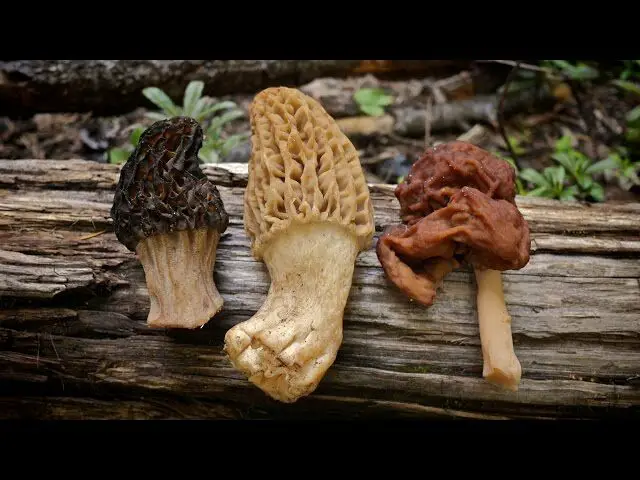
Table of Contents
7 types of edible morel mushrooms
We will discuss types of edible morel mushrooms for spring mushroom hunting. With morels cap, stem size, growing places, features, and uses.
Common morel (Morchella esculenta)
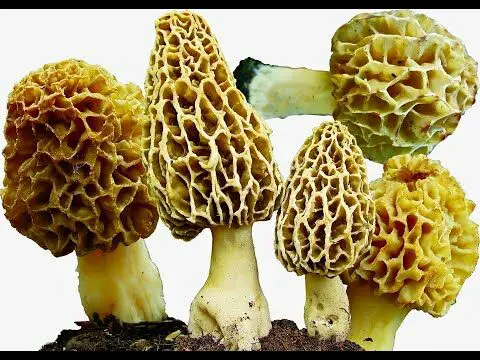
- fruit body. Height can reach 20 cm; almost round, only occasionally somewhat elongated; the cap occupies 1/2-2/3 of the height of the stem; all over the head there are wide depressions, the so-called alveoli, they are formed by ribs and paths, often folded together; light brown or light yellow with a hint of brown; hollow inside, as well as a brighter, uniformly colored rod;
- Stem 2-4 cm in diameter. Thick at the base; its surface is wrinkled and covered with small sticky grains;
- The flesh is whitish, creamy, and brittle. Pleasant taste and smell;
- Spore powder whitish-yellowish;
- Spreading. Quite a rare sight. Most often grows in groups, but singly growing specimens can also be found. Fruiting bodies appear in spring, from April to early June, in light forests, rather on fertile soils rich in organic residues, willingly along the banks of rivers and streams, among butterburs, in the grass, on grassy forest edges, among hedges, in flower beds. Also found in orchards and orchards under fruit trees. This fungus avoids fertilized soils;
- Application. Morel is a real tasty mushroom with a specific, delicate taste. In its raw form, it exhibits weak poisonous properties;
- There are a number of varieties of this species, which differ from the main form mainly in color and head shape. The common variety (Morchella esculenta var. Vulgaris) has a dark brown, sometimes almost black head, the round variety (Morchella esculenta var. Rotunda) has a spherical head and less pronounced ribs, the dark variety (Morchella esculenta var.) has light ribs against dark alveoli and a white variety (Morchella esculenta var. alba) with nearly white heads. Thick-legged lard (Morchella esculenta var crassipes) forms large fruiting bodies with particularly long and bulky stems;
- Morels are classified as ascomycetes because their spores are produced in so-called sacs that sit on a pitted surface.
Read out guide on Mushrooms That Grow In Fall.
Early Morel (Verpa bohemica)
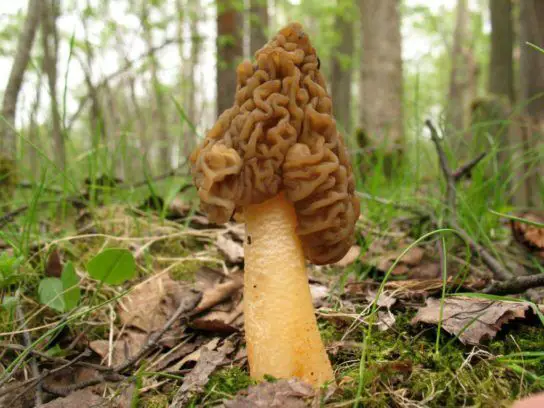
- fruit body. Head ocher-brown, lighter below, bell-shaped, with long, narrow, wavy, more or less vertical ribs, free;
- Stem size 6-14 – 1.5-3 cm. Whitish or ocher, first full, then empty;
- The pulp is white, crumbly-waxy consistency, pleasant taste and smell;
- Spore powder is ocher-yellow;
- Spreading. It occurs rarely, in April-May, in prominent places of deciduous forests and shrubs, in humid places, above watercourses;
- Application – edible;
- May be confused with conical morel (lat. Morchella conica) or semi-free miter (lat. Mitrophora semilibera).
True morels (Morchella conica)
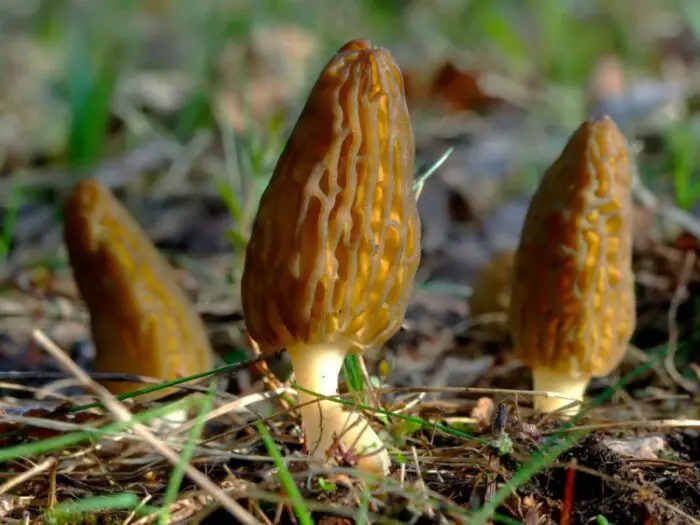
- fruit body. Up to 12 cm high, the cap occupies 1/2 – 2/3 of the height of the stem, cone-shaped, elongated; the brim of the hat is more or less fused; strong longitudinal rods run clearly parallel from top to bottom and are interconnected by very differently grown weak crossbars; the color varies from gray-brown to olive-brown, the ribs blacken in old age; empty inside;
- Stem. Narrower heads (1/2 – 2/3 head diameter) and slightly shorter, white ocher, surface covered with small grains, empty inside;
- The pulp is whitish, and creamy;
- Spore secretions are whitish;
- Spreading. It grows in riverine and spruce forests, on edges and roads, in wood warehouses. Pretty rare mushroom; more common in the mountains; appears depending on the length of winter, from March to the end of May;
- Application. Very tasty mushroom;
- Possible mistakes. Inexperienced mushroom pickers may confuse the morel with the poisonous chestnut leaflet;
- Morels are found in the temperate climate zone of the Northern Hemisphere, as well as in Australia. Morchella esculenta and Morchella elata are more like a cone. Note that the conical morel and the common morel have regular cap ribbing, while the edible morel does not.
Half-free morel (Morchella semilibera)
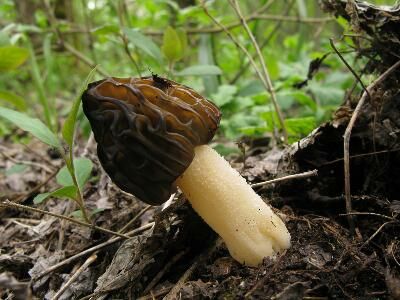
- fruit body. The cap is only half attached to the stem, the rest is free and may stick out a little; can vary considerably in size, from 1 to 4 cm; the surface is ribbed, between high and thin vertical ribs there are alveoli arranged in vertical rows and separated by low lamellae, yellow-brown, light brown to olive brown, ribs and plates from dark brown to black-brown;
- The stem is whitish, yellowish, has a length of 3 to 10 cm and a diameter of about 1-2 cm, empty inside;
- Pulp. This type of morel has a rather thin layer of pulp, therefore it is less valued, rather brittle. The smell is clean, pleasant;
- Cream-colored spores;
- Spreading. It occurs in early spring, often in groups, hiding in dense grass. In warmer parts of Europe, it grows in greater numbers. Likes dense tugai forests on fertile soils, damp places, found along forest roads and paths;
- Application – edible, under partial protection.
Here is guide on Mushrooms That Grow Underground.
Black Morel (Morchella elata)
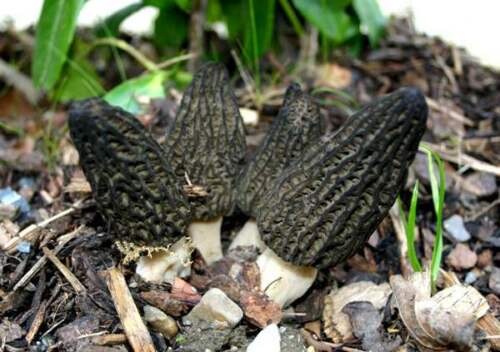
- The fruiting body consists of a head and a body, 5-10 (15) cm; the head with a generic (spore-forming) layer is narrowly conical, olive-brown, black-brown, reddish-brown, and mostly dark; the height of the head is from 1/2 to 2/3 of the height of the entire fruiting body; the edges of the pits are arranged in parallel vertical lines, blackening with age, separated by short transverse “rails”;
- Stem hollow, cylindrical, whitish, with age light brown, granular-mottled;
- Spore secretions are creamy;
- Application – edible, very tasty;
- Spreading. One of the early models. Appears in coniferous forests, on solonetsous, poor soils, singly or in groups, in damp places and in timber stores, in mists, or in sawmills.
Morchella crassipes
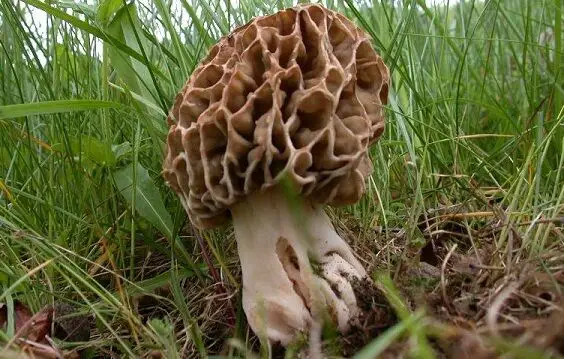
- fruit body. Height: 12-20 (30) cm, head 5-15 cm in diameter, blunt-conical, deep pits on the surface separated by sinuous, longitudinal, and lower transverse ribs. The pits are lined with a spore-bearing layer: brown, gray, or rusty brown;
- Stem 6-15 cm high, 4-8 cm thick, yellowish-cream, ocher, ocher-brown, almost the same width as the head, thickens downwards, unevenly wrinkled, furrowed, pitted;
- The pulp is white, creamy, white, thin and crumbly, odorless and tasteless;
- Spore secretions paleochlate, rum;
- Spreading. Occurs rarely. It grows along the edges of light forests with a predominance of ash and white poplar, and grows singly or in groups. Close view: morels (lat. Morchella esculenta);
- Application edible;
- Like all morels, it is partially protected in some countries. When consumed raw, it can cause serious gastrointestinal poisoning. The young specimen is nearly identical to the edible morel.
Look out Mushrooms That Grow Under Oak Trees.
Verpa conica
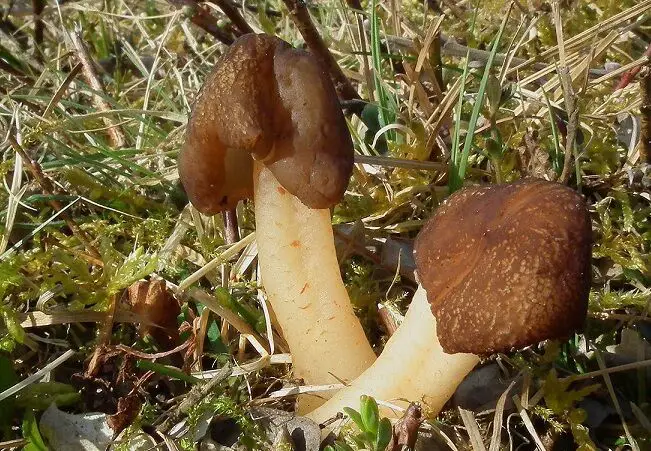
- fruit body. Refers to the type of morels. Can be distinguished from morels by the way the cap is attached to the stem. In morels, the stem is connected to the cap at the very bottom, in morels only under the top of the cap. The conical thimble has an almost smooth cap, while the Czech morel (lat. verpa bohemica) has long wavy ribs. The stem of the grown thimble is much longer than the cap, the height of which is from 2 to 4 cm;
- The stem of a grown thimble is much longer than the cap, from 3 to 10 cm and 0.5 to 1.5 cm wide. The shaft is empty inside;
- The pulp is very thin;
- Spore secretions are broadly ellipsoid, smooth, and colorless. Much smaller than morels, each bag contains eight spores (morels have two, sometimes four). Spores reach maturity only when the fruiting body begins to decompose;
- Spreading. Grows in deciduous forests, under bushes of aspen, mountain ash, alder, and blackthorn, in riverine thickets, in the middle part of the northern hemisphere, rarely in very cool areas. He shows up early;
- The smell is weak, barely perceptible, pleasant;
- The taste is very rich, and pleasant. Slightly nutty/spicy;
- Application edible.
Is Morel an edible fungi?
The answer to this question is not obvious. The Latin name for morels is “morchella esculenta”, where “esculenta” means “edible”. In fact, in many sources, these mushrooms are described by the full name, meaning “edible morel.” This should complete the answer to the question of whether morels are poisonous mushrooms. However, this is not quite true. Before use, morels must be subjected to heat treatment. Regardless of whether we decide to stew, fry, or bake them, in the end, we will get mushrooms that are completely edible and do not pose a danger to humans. Therefore, in this case, we can safely say that morels are not poisonous.
Can you eat raw Morel?
Eating morels raw is categorically not recommended then they can show toxic properties and be poisonous to humans. Here it is difficult to put them on a par with the most poisonous mushrooms, such as grebes (for example, greenish grebe). Eating morels, even raw, is unlikely to be as tragic as eating toadstools. Raw morels are said to be slightly poisonous to humans. However, this makes the risk definitely not worth it, and it is better to subject these mushrooms to an appropriate heat treatment. Then they will not only taste better but, above all, their use will be safe.
causes of Morel mushroom poisoning
The most common causes of mushroom poisoning are simply mistakes. The toadstool ends up in the mushroom picker’s basket as a completely different species, and therefore a tragedy can occur. The seemingly unique appearance of morels reduces the risk of confusing them with poisonous mushrooms. However, even morels have twins, unfortunately, dangerous ones.
The main role here is played by Gyromitra esculenta, which looks very similar to the morel, but is a poisonous mushroom and is not suitable for human consumption.
Interesting! For many years it was considered an edible mushroom, and its Latin name still includes the adjective “esculenta” meaning “edible”. However, after it was established that Gyromitra esculenta was the cause of the poisoning, it was forbidden to sell it. This is another reason why we should only buy mushrooms from trusted sources.
edible morel mushroom nutrition facts
Edible morels are valued primarily for their unique taste. However, they are also distinguished from other mushrooms by the content of many valuable minerals and vitamins. The energy value of 100 grams of sardines is almost 30 kcal. The same amount of product contains 3.12 grams of protein, 5.1 grams of carbohydrates, 0.57 grams of fat, and 2.8 grams of fiber.<
Morels are also a rich source of many minerals. These include:
- Iron,
- Potassium,
- Phosphorus,
- Zinc,
- Magnesium.
Due to their relatively high fiber content, they have a positive effect on the digestive system. Potassium, which 100 grams of sardines contain 411 milligrams, also has a beneficial effect on the human body. These mushrooms also contain traces of many vitamins.
Conclusion
IF you are thinking of going for morel mushroom hunting and not sure about the types of edible morel mushrooms. then read the above guide carefully. You can learn and identify the morel mushrooms with images and characteristics.